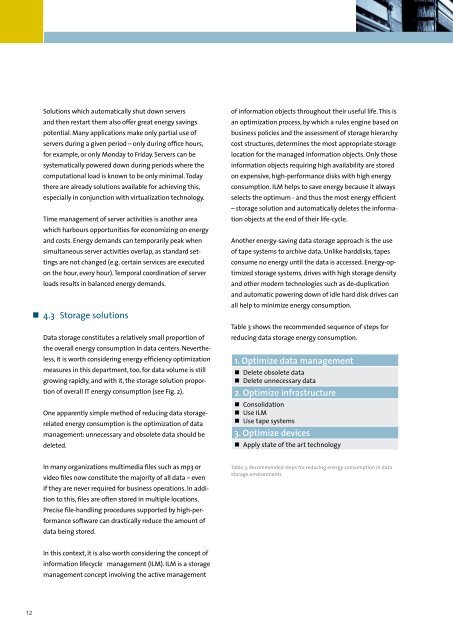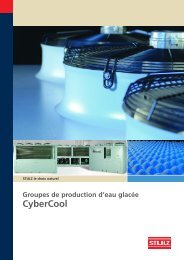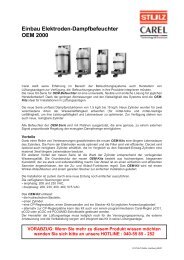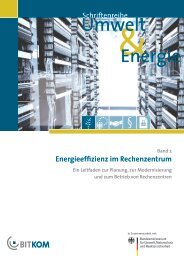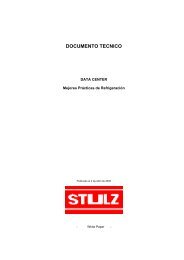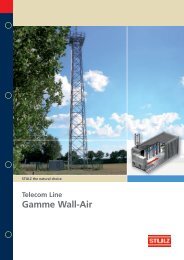Climate protection needs energy efficient data centers - Stulz GmbH
Climate protection needs energy efficient data centers - Stulz GmbH
Climate protection needs energy efficient data centers - Stulz GmbH
You also want an ePaper? Increase the reach of your titles
YUMPU automatically turns print PDFs into web optimized ePapers that Google loves.
Solutions which automatically shut down serversand then restart them also offer great <strong>energy</strong> savingspotential. Many applications make only partial use ofservers during a given period – only during office hours,for example, or only Monday to Friday. Servers can besystematically powered down during periods where thecomputational load is known to be only minimal. Todaythere are already solutions available for achieving this,especially in conjunction with virtualization technology.Time management of server activities is another areawhich harbours opportunities for economizing on <strong>energy</strong>and costs. Energy demands can temporarily peak whensimultaneous server activities overlap, as standard settingsare not changed (e.g. certain services are executedon the hour, every hour). Temporal coordination of serverloads results in balanced <strong>energy</strong> demands.• 4.3 Storage solutionsData storage constitutes a relatively small proportion ofthe overall <strong>energy</strong> consumption in <strong>data</strong> <strong>centers</strong>. Nevertheless,it is worth considering <strong>energy</strong> efficiency optimizationmeasures in this department, too, for <strong>data</strong> volume is stillgrowing rapidly, and with it, the storage solution proportionof overall IT <strong>energy</strong> consumption (see Fig. 2).One apparently simple method of reducing <strong>data</strong> storagerelated<strong>energy</strong> consumption is the optimization of <strong>data</strong>management: unnecessary and obsolete <strong>data</strong> should bedeleted.of information objects throughout their useful life. This isan optimization process, by which a rules engine based onbusiness policies and the assessment of storage hierarchycost structures, determines the most appropriate storagelocation for the managed information objects. Only thoseinformation objects requiring high availability are storedon expensive, high-performance disks with high <strong>energy</strong>consumption. ILM helps to save <strong>energy</strong> because it alwaysselects the optimum - and thus the most <strong>energy</strong> <strong>efficient</strong>– storage solution and automatically deletes the informationobjects at the end of their life-cycle.Another <strong>energy</strong>-saving <strong>data</strong> storage approach is the useof tape systems to archive <strong>data</strong>. Unlike harddisks, tapesconsume no <strong>energy</strong> until the <strong>data</strong> is accessed. Energy-optimizedstorage systems, drives with high storage densityand other modern technologies such as de-duplicationand automatic powering down of idle hard disk drives canall help to minimize <strong>energy</strong> consumption.Table 3 shows the recommended sequence of steps forreducing <strong>data</strong> storage <strong>energy</strong> consumption.1. Optimize <strong>data</strong> management• Delete obsolete <strong>data</strong>• Delete unnecessary <strong>data</strong>2. Optimize infrastructure• Consolidation• Use ILM• Use tape systems3. Optimize devices• Apply state of the art technologyIn many organizations multimedia files such as mp3 orvideo files now constitute the majority of all <strong>data</strong> – evenif they are never required for business operations. In additionto this, files are often stored in multiple locations.Precise file-handling procedures supported by high-performancesoftware can drastically reduce the amount of<strong>data</strong> being stored.Table 3: Recommended steps for reducing <strong>energy</strong> consumption in <strong>data</strong>storage environmentsIn this context, it is also worth considering the concept ofinformation lifecycle management (ILM). ILM is a storagemanagement concept involving the active management12


